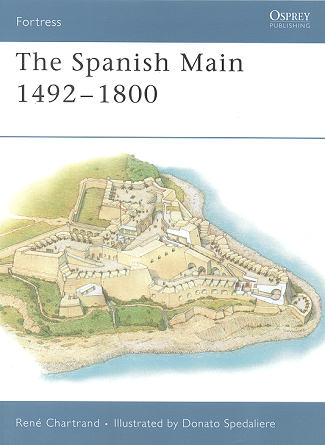
|
Title: |
The Spanish Main 1492-1800 |
|
Author: |
Rene' Chartrand, illustrated by Donato Spedaliere |
|
Publisher/Distributor |
Osprey Publishing |
|
Price |
$16.95 MSRP |
|
Reviewer: |
|
| Notes: |
64 pages, 7¼ x 9¼
inches, softbound ISBN: 1-84603-005-6 |

We have all heard of the Spanish Main. It is part and parcel of every pirate movie ever made, but what is it? Well originally it was considered to be the northern coast of South America, but actually it encompasses the entire Caribbean and all the Spanish possessions within.
There were key cities involved in the Spanish plunder of Indian gold and silver and the delivery of that loot to Spain. It includes Havana, St Augustine, Veracruz, Caragena, San Juan and a number of others. All of these places were stopovers for the treasure fleet and so had to be protected from an increasing number of pirates and privateers, who would either sack a town or ransom it. Later, the British and French fleets would do the same thing.
The protection for these towns originally took the form of wood and earthen defenses, but these were easily overrun so the only real thing to do was to build fortresses with cannon and troops to man them and fight against invaders.
This began the largest fortress-building campaign in the Americas, something that has never been surpassed or equaled since. The amount of money put into these structures is enormous and put quite a strain on the Spanish over the years. Fortresses are not always enough or as well done as one would wish and so the construction and maintenance of these structures waxed and waned with the political situation.
The author, Rene' Chartland, takes us through the initial build up in the 16th Century right up to the 19th century when these fortresses were no longer needed as Spain had diminished quite a bit as a world power by then and the treasure had virtually disappeared. Throughout the book the design and purpose of each of these structures is covered in detail, making it quite fascinating reading.
Politics often drives these things and that is taken into account during the book as well. The life and conditions of the people manning these forts is also covered so we get a brief glimpse into that aspect of things as well. Throughout the book are period artwork, modern illustrations by Donato Spedaliere, and photos of the structures as they now look. Just about all of these forts are still extant and several have been carefully restored, such as the ones in San Juan, Havana, and St. Augustine.
Overall, another superb Osprey book on a most interesting subject and one I know you will enjoy as much as did I.
September 2006
For more on the complete line of Osprey books, visit www.ospreypublishing.com or contact them at Osprey Direct, PO Box 140, Wellingborough, Northants, NN8 2FA, UK. In the US, it is Osprey Direct at 44-02 23rd St, Suite 219, Long Island City, NY 11101., where you can get a catalogue of available books.
If you would like your product reviewed fairly and quickly by a site that has nearly 325,000 visitors a month, please contact me or see other details in the Note to Contributors.